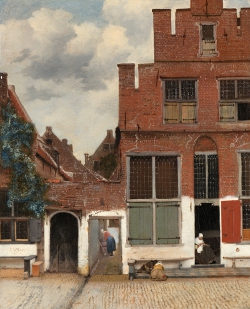
Johannes Vermeer
c. 1657–1661
Oil on canvas, 54.3 x 44 cm.
Rijksmuseum, Amsterdam
A current exhibition at the Rijksmuseum presents Frans Grijzenhout's new theory about the location of the scene shown by Johannes Vermeer in The Little Street (Figure 1).Frans Grijzenhout, Vermeer's Little Street: A View of the Penspoort in Delft (Amsterdam: Rijksmuseum, 2015). Grijzenhout's proposal is that the painting shows what are today Numbers 40 and 42 Vlamingstraat in Delft.The houses would not have been numbered in the seventeenth century. This idea is based on measurements he has found in the Legger van het diepen der wateren binnen de stadt Delft [Ledger of the dredging of canals in the town of Delft], a document compiled from 1666 onwards recording the widths of house frontages for tax purposes.Legger van het diepen der wateren binnen de stadt Delft, ms 1666–1667: see Frans Grijzenhout, Vermeer's Little Street: A View of the Penspoort in Delft (Amsterdam: Rijksmuseum, 2015), 26–27.
The Little Street shows two houses separated by two gateways. In the Legger there are two gateways recorded between 40 and 42 Vlamingstraat. The respective widths given by the Legger for the houses and gateways, converted to metres, are as follows:
| Number 40 | 6.25 m |
| Left-hand gateway | 1.25 m |
| Right-hand gateway | 1.25 m |
| Number 42 | 6.25 m |
Grijzenhout says that this is the only case in the whole of Delft according to the Legger where there are two adjoining gateways. He has no contemporary drawings of the houses that were on the site in the seventeenth century. (The houses there today are of more recent dates.) The theory thus rests wholly on the plan dimensions from the Legger.
A width of 6.25 metres is plausible for the right-hand house in The Little Street. However a cadastral map of Delft made in 1832, reproduced by Grijzenhout, shows a different situation on Vlamingstraat from the measurements in the Legger (Figure 2).Frans Grijzenhout, Vermeer's Little Street: A View of the Penspoort in Delft (Amsterdam: Rijksmuseum, 2015). Figure 23 p.34. Grijzenhout gives the date of the map as 1823. But the first cadastral maps of Dutch towns were made in 1832. There is in this map only one gateway between the two houses, leading to a passage alongside No. 42. Grijzenhout proposes that the left-hand passage alongside No. 40 was blocked at the street front at some stage. If we assume, with Grijzenhout, that in the seventeenth century this passage was open to the street and reached by a second gateway, we get a new set of dimensions from the 1832 map:
| Number 40 | 4.75 m |
| Left-hand gateway | 1.25 m |
| Right-hand gateway | 1.25 m |
| Number 42 | 6.25 m |
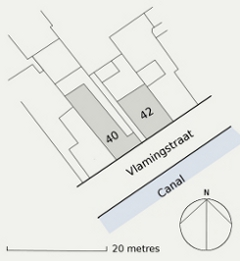
The frontage width of Number 40 is not now as given in the Legger. It is significantly narrower: 4.75 metres instead of 6.25.
Since this is Grijzenhout's central piece of evidence, this inconsistency must surely throw serious doubt on his theory. Either the Legger is wrong, or the cadastral map is wrong. Did the nodding compiler of the Legger absent-mindedly record two gateways instead of one? (If there had indeed been only one gateway, his widths for the two houses would have been correct.) The dimensions of the cadastral map are likely to be accurate, since the map was made for assessing taxes using modern surveying techniques. The positions and measurements of the two houses in the 1832 map match closely to today's maps, as for example Google Maps.
There are two more problems with Grijzenhout's theory. Architectural historians agree that the house on the right in the painting is very old. It dates probably from before 1536, when a disastrous fire destroyed most houses on Vlamingstraat. This of course would tend to indicate that the building shown by Vermeer was elsewhere in the city. Grijzenhout reproduces a painted map showing just one house surviving the fire on Vlamingstraat.Frans Grijzenhout, Vermeer's Little Street: A View of the Penspoort in Delft (Amsterdam: Rijksmuseum, 2015)., Figures 20 and 21, p.31: Anonymous, Map of Delft after the Fire of 1536, probably c.1620; and detail. But there is no evidence to show this is Number 42. Nothing daunted, his reaction is to cast doubt on the fire map's reliability.
Grijzenhout goes on to make a schematic plan and a sketch perspective of the site of Nos 40 and 42 Vlamingstraat, with the buildings in The Little Street superimposed.Frans Grijzenhout, Vermeer's Little Street: A View of the Penspoort in Delft (Amsterdam: Rijksmuseum, 2015), 35-36, fig. 24 on p. 37. The ‘ultimate test' for him lies in the house in the background, whose gable is visible above the right-hand gateway, with a tree in front of it. This he suggests is the ‘back house' of what is today No. 190 Rietveld, the street on the opposite side of the block from Vlamingstraat. Grijzenhout shows the back houses of Nos 40 and 42 Vlamingstraat separated from the back house of 190 Rietveld just by a small garden.
However a glance at either the 1832 map or a modern map shows that the block is much deeper than shown in Grijzenhout's sketches (Figure 3). It measures about 73 metres at this point. This means that at a broad estimate the back houses in question would have been separated by perhaps 30 metres. It is possible to make a rough calculation, working from Vermeer's perspective, of how high the back house at 190 Rietveld would have to be, to match the appearance in The Little Street. It would have to be some 20 metres tall (five or six storeys), an improbable dimension for a seventeenth century private house in this poor part of Delft.
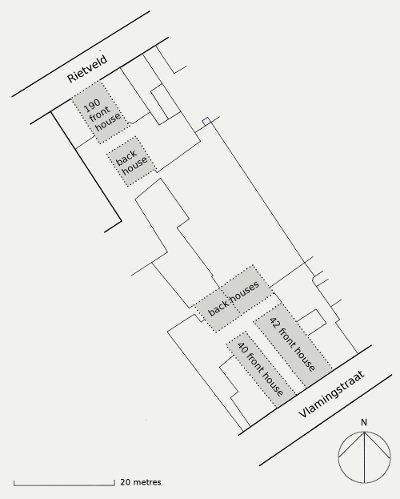
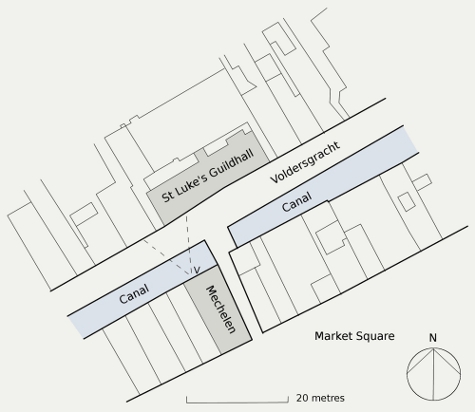
If Grijzenhout's theory has several holes, so much so that it lacks credibility, there have been other proposals for the location suggested in the past that have rested on more solid foundations. It was Pieter Swillens who first suggested in 1950 that the painting shows buildings on the Voldersgracht, behind Mechelen, the inn on the Market Square owned by Vermeer's family where the painter lived before his marriage. The picture, Swillens proposed, could have been painted from a back window of Mechelen.P. T. A. Swillens, Johannes Vermeer: Painter of Delft 1632–1675 (Utrecht and Brussels: Spectrum, 1950), 95. Figure 4 shows the locality in the 1832 map.
The topographic artist Abraham Rademaker made a drawing around 1700 of the buildings on the opposite side of the Voldersgracht from Mechelen (Figure 5).The Rademaker drawing is in the Delft Municipal Archive. The building on the right in this drawing with the attached pilasters and triangular pediment is the St Luke's Guildhall, the headquarters of the guild of painters and other crafts to which Vermeer belonged, and of which he became the headman at the age of 29. Notice the resemblance of the round-headed gateway in this drawing to the left-hand gateway in The Little Street. Vermeer shows rather little of the house at the left, but from what is visible, it could be the same as the house on the left in Rademaker's drawing.
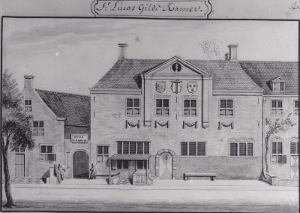
Notice also the seat on the street to the left of the round-arched gateway, shown in both painting and drawing (occupied by two figures in the drawing). And see the area of diagonal checkerboard tiles in front of the right-hand building in the painting, which reappear beneath what seems to be a canopied stall or small shop in Rademaker's drawing. These details are shown enlarged in (Figure 6). The main discrepancy is of course the St Luke's Guildhall, constructed (or rather reconstructed) in 1661.
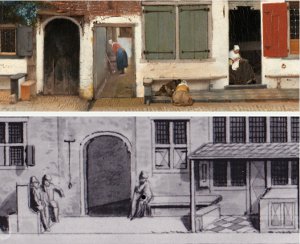
It is thought that The Little Street was painted in the late 1650s. At that time the site at the right—if Swillens' identification is correct—was occupied by a charitable institution for the care of the elderly, the Old Men's House. (In Rademaker's drawing there is a board above the arched doorway with the inscription ‘Oude Manhuis', showing that it gave access to this institution's remaining buildings behind the Guildhall.) Figure 7 shows the Old Men's house as it appears in Willem Blaeu's pictorial map of Delft of 1648. We are looking from the west. The street and canal of the Voldersgracht are on the south side (at the right in the view).
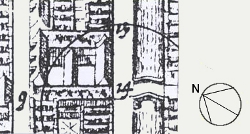
Four ranges surround a courtyard, with a single-storey building dividing the court into two parts. The bridge across the canal in this view leads to an alley running past the side of Mechelen and through to the Market Square. Look at the range along the west side of the courtyard (the side nearest to us) that has the figures ‘9' and ‘24' at the two ends. This meets the Voldersgracht in a gable end (next to the figure ‘24'). This could have been the building with the gable at the right of The Little Street.
In 1661 the range of the Old Men's House on the south side, running along the street, was converted to create the Guildhall of Saint Luke. Figure 8 shows a detail from Dirck van Bleyswijk's pictorial map of 1675–1679.The van Bleyswijck map is published in book form in a modern edition, H L Houtzager et al, De Kaart Figuratief van Delft, (Uitgeverij Elmar, Rijswijk 1997). We are again looking from the west. We get a very clear view of the new hall, which is labelled as such. We can see the hipped roof and the triangular pediment on the street front. The building is taller than the remaining parts of the Old Men's House.
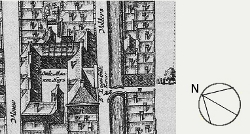
Comparing the two maps, we see that the range on the near side of the Old Men's House, which previously ran through to the Voldersgracht, has been shortened. It is just possible to see also that the Guildhall building now extends somewhat further to the west—further towards us in the view—than the building it has replaced. That is to say, in relation to the view of The Little Street, the Guildhall extends some short distance further to the left than the gable end of the Old Men's House building shown by Vermeer. The plan of the Guildhall is shown in the cadastral map of 1832 (Figure 4), where it can be seen that there is just one gateway between the Hall and a house to the west (to the left in the map).
Around 1732 Leonard Schenk made an engraving from Rademaker's drawing (Figure 9).P. T. A. Swillens, Johannes Vermeer: Painter of Delft 1632–1675 (Utrecht and Brussels: Spectrum, 1950), 95, pl. 60b. Swillens made a tracing of the St Luke Guildhall from this engraving and superimposed it over The Little Street (Figure 10).P. T. A. Swillens, Johannes Vermeer: Painter of Delft 1632–1675 (Utrecht and Brussels: Spectrum, 1950), 95, pl. 61b. He showed the new Hall extending—as in van Bleyswijk's map—slightly further to the left, filling in the passage behind the right-hand gateway in the painting. I have argued in an essay published a dozen years ago that Swillens' basic idea was correct, but that he made two mistakes.Philip Steadman, ‘A photograph of The Little Street', accessed November 8, 2023. The first mistake was to rely too heavily on the dimensions indicated by the Rademaker drawing and the Schenk engraving.
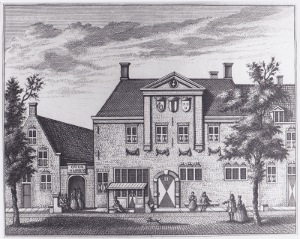
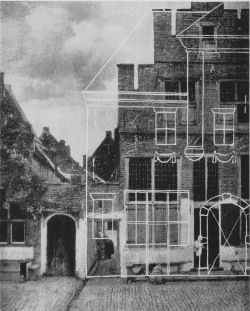
The Saint Luke Guildhall was demolished in the late 19th century, but a photograph from 1875 survives (Figure 11).The photograph is held in the Delft Municipal Archive, and is reproduced in Swillens 1950 Plate 37a. At this date the triangular pediment has gone, but the attached pilasters remain, as do the carved stone swags below the windows that appear in Rademaker's drawing. Comparison of drawing with photograph shows however that although Rademaker has faithfully depicted all the various elements of the façade, he has got some of their proportions and spacing wrong. He has got the upper floor windows too small, and has allowed much wider expanses of brickwork at the two ends of the façade than in the real building. The discrepancies are even greater in the Schenk engraving. I have made a scale drawing of the façade, working from the photograph (Figure 12), which is possible since the length of the building is known from the 1832 map, and the height can be gauged in proportion, as well as from the height of the standing policeman.
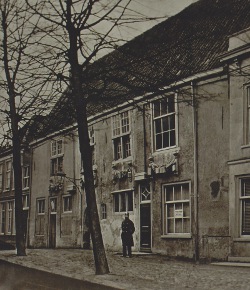
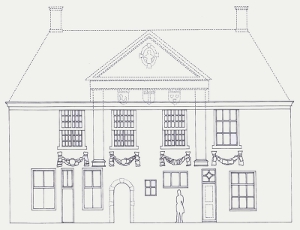
This façade has some strange features. The upper storey is all neatly and classically symmetrical. The four windows are the same size and shape, and are regularly spaced. The ground floor however is a jumble of oddly placed openings of different shapes and sizes. The round-arched doorway is not central, and the other two square-headed doors are not symmetrically positioned. Strangest of all, the pilasters are not brought down to the ground, but are left unsupported half way up the façade.
Swillens, believed, with others, that the Guildhall of Saint Luke completely replaced the street range of the Old Men's House. This was his second mistake. In fact it was just the upper floor that was converted for the Guildhall (and the building extended slightly to the left, as we have seen). But the ground floor remained unchanged. This explains the strange disjunction between upper and lower floors.
The historian Dirck van Bleyswijck described the conversion in his Beschrijving der Stadt Delft of 1667.Dirck van Bleyswijck, Beschrijving der Stadt Delft (Delft, 1667), vol. 2, p. 646ff; see also P. T. A. Swillens, Johannes Vermeer: Painter of Delft 1632–1675 (Utrecht and Brussels: Spectrum, 1950), 35-37. The new headquarters of the Guild was converted from the Old Men's House chapel "which had latterly served as a cloth-testing hall." It was a single room ("a very large and airy room") on the upper floor. As the modern historian and Vermeer expert J M Montias explains, "The burgomasters of Delft, at their session of 3 September, 1661, had consented ‘at the repeated demand of the St Lucas guild… to allow the guild the use of the great upstairs hall with a small room beside it… in the Old Men and Women's House on the Voldersgracht."J M Montias,"Vermeer and his Milieu: Conclusion of an Archival Study', Oud Holland vol.94, 1980 pp. 44–62: see pp. 58–59. [my emphasis]
Grijzenhout discusses Swillens's identification of The Little Street with the site on the Voldersgracht, and reproduces his superimposition of Schenk's engraving over the painting (Figure 10).Frans Grijzenhout, Vermeer's "Little Street": A View of the Penspoort in Delft (Amsterdam: Rijksmuseum, 2015), 19-21, fig. 12 on p. 20. He says that A J J M van Peer "had already advanced well-founded objections to [the theory] in 1959," and takes these to have conclusively refuted Swillens.A. J. J. M. van Peer, "Rondom Jan Vermeer van Delft," Oud Holland 74 (1959): 240-245. But van Peer's arguments were not well founded. He argued that the Old Men's House was entirely within the block and did not front onto the Voldersgracht. This is plainly contradicted by the Blaeu map. Van Peer also claimed that the chapel was converted for use by the Saint Luke's Guild without rebuilding, and that there was therefore no question of an older house—painted by Vermeer—having been pulled down. Here I believe he was again wrong, but not so far from the truth. As I have argued, the older building was altered but not completely replaced from the ground up.
J M Montias also disagreed with Swillens for two main reasons.John Michael Montias, Vermeer and His Milieu: A Web of Social History (Princeton, NJ: Princeton University Press, 1989), 58–59. First, Montias says that the street front of the Old Men's House as shown in the Blaeu map "bears little resemblance to the gabled house on the right of Het Straatje [The Little Street], the short side of which abuts the street." But Montias overlooks the western range of the building, whose gable end does abut the Voldersgracht in the relevant position (next to ‘24' in the Blaeu map). Second, Montias argues that Swillens's superimposition of Schenk's engraving over Vermeer's painting would indicate a much more extensive, and expensive, rebuilding than is recorded in the Guild's accounts. But this is a misapprehension flowing, I would suggest, from the inaccuracies of Schenk's engraving. Only the upper floor was changed.
If instead we superimpose my own accurately scaled drawing—made from the 1875 photograph—over The Little Street (Figure 13) we find that the two ground floor windows and the door at the left between them match closely to the windows and door of the building shown in the painting. The photograph shows some fragmentary remains of the Old Men's House building painted by Vermeer in the 1660s.
If The Little Street does indeed show the buildings on the Voldersgracht, as I believe I have shown, then measurements of the widths of the buildings and gateways can be obtained from cadastral and modern maps. From these it is possible, since we see the buildings frontally, to estimate their heights. These show that the ground floor of the building on the right is 5.5 metres high. The building has often been described as a house. This would be a tall ground storey for a private dwelling. But it could be a reasonable height for the entrance to a charitable institution, the Old Men's House.
It is also possible to make an estimate of the location of the theoretical perspective viewpoint of the painting. In the painting the right-hand gate is open and we can see down a passage where a woman leans over her work. This passage is visible in the 1832 cadastral map. If we assume that the far end of the passage coincides with the buildings behind the Guildhall, then we have a dimension for its length. This makes it possible to find the viewpoint, on the opposite side of the Voldersgracht. (The point is marked V in Figure 4, where the angle of view is shown with broken lines.) There are uncertainties involved, but by my calculations, the viewpoint is about 10 metres distant. The width of the street plus the canal at this point is 11 metres. So this result does appear to be compatible with a vantage point in a rear window of Mechelen.I arrived at these figures by my own calculations. But they are confirmed independently by F. H. Kreuger, "Vermeer's "Little Street" and its Location," accessed November 8, 2023,. (For 40/ 42 Vlamingstraat, this distance would place the viewpoint in the centre of the canal.)
Grijzenhout cites a perspective study of The Little Street made in 1923 by Eduard Houbolt who estimated the distance of the viewpoint from the street front at "between seventeen and twenty metres".Frans Grijzenhout, Vermeer's Little Street: A View of the Penspoort in Delft (Amsterdam: Rijksmuseum, 2015), 15. But Houbolt seems to have arrived at this figure from an intuition that the view was from further away than the width of a typical Delft street, rather than on any evidence to be found in the perspective geometry of the picture itself.
If there were two gateways between the house on the left in The Little Street and the Old Men's House, why did Grijzenhout not find these in the Legger? The answer is simple: the conversion to the St Luke's Guildhall with the removal of the right-hand gate took place in 1661, while the Legger was first compiled in 1666.
Grijzenhout feels that No 42 Vlamingstraat would have had particular resonance for Vermeer, since the house was occupied at this date by Ariaentgen Claes van der Minne, one of Vermeer's aunts. Ariaentgen had a business selling tripe in the town's meat market. But would not a site for The Little Street on the Voldersgracht have held rather more meaning for the painter: a view from his family home, across to a building just about to be converted for use by his own profession's guild?
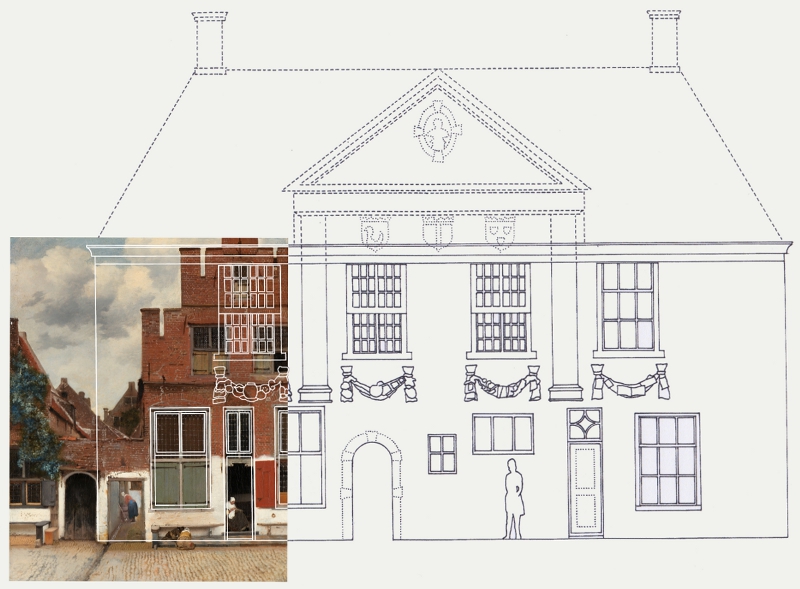

Philip Steadman
2001
Philip Steadman is Emeritus Professor of Urban and Built Form Studies at University College London. He trained as an architect, and has taught at Cambridge University and the Open University. He has published several books on geometry in architecture, and on computer-aided design. In the 1960s he edited and published Form, a quarterly magazine of the arts, and co-authored a book on kinetic art. He has contributed to a number of exhibitions, films, and books on perspective geometry and the history of art. In 2001 he published Vermeer's Camera (Oxford University Press), on the painter's use of the camera obscura.
Click here to read an exclusive Essential Vermeer interview with Mr. Steadman..